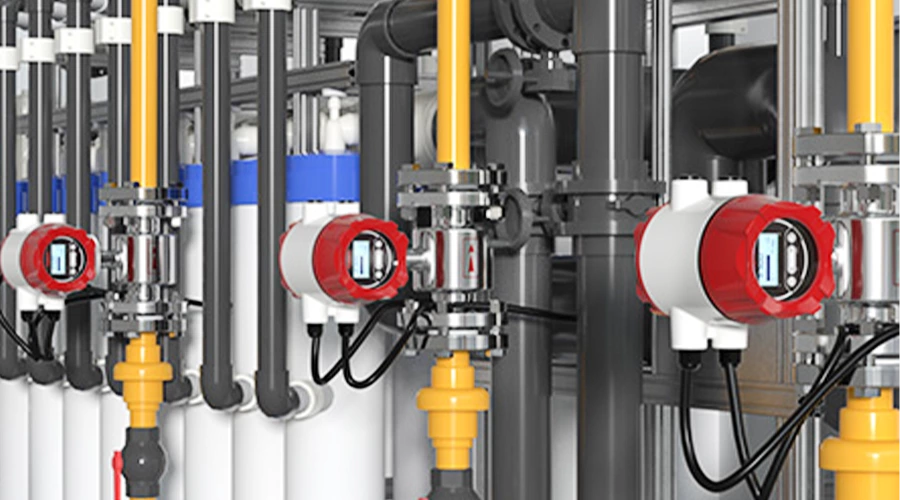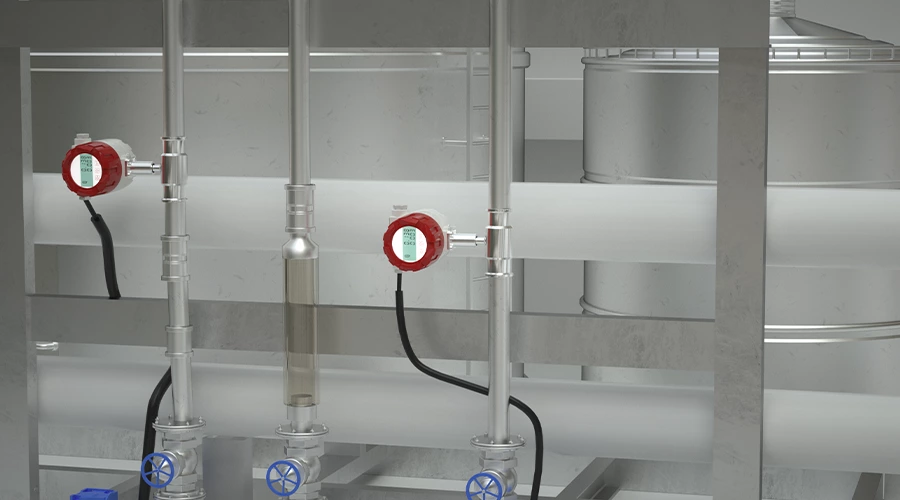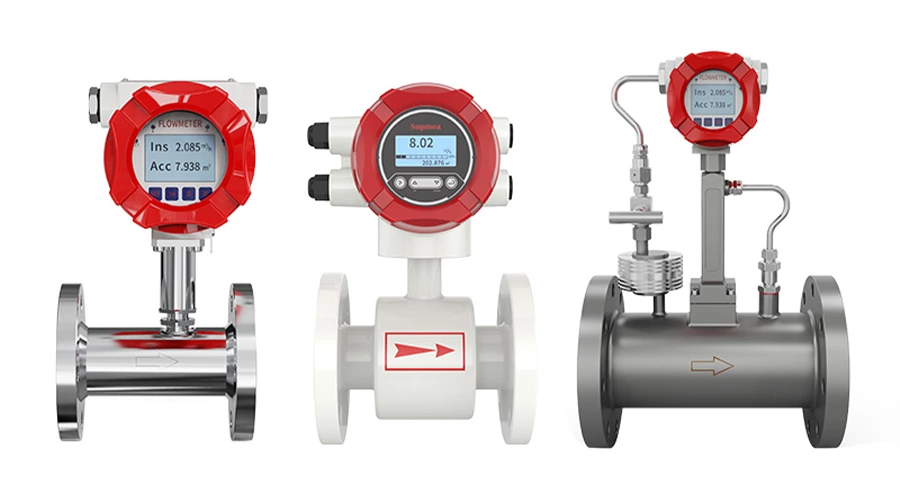Flow Rate And Pressure: Features, Relationship & Applications
What’s The Relationship Between Pipe Diameter, Pressure, And Flow?
The relationship between pipe diameter, pressure, and flow is described by the Bernoulli's principle and the continuity equation.
According to Bernoulli's principle, as the diameter of a pipe decreases, the velocity of the fluid passing through it increases, and the pressure decreases. Conversely, as the diameter of the pipe increases, the velocity decreases, and the pressure increases.
The continuity equation states that the flow rate of a fluid through a pipe is constant, meaning that the mass flow rate or volume flow rate must be the same at all points along the pipe. Therefore, if the pipe diameter decreases, the fluid must flow faster to maintain the same flow rate, which leads to a decrease in pressure due to Bernoulli's principle. Similarly, if the pipe diameter increases, the fluid can flow slower and the pressure can increase.
In practical applications, engineers and designers need to consider the balance between pipe diameter, pressure, and flow rate to optimize system performance and efficiency. For example, increasing the pipe diameter can reduce pressure drop and increase flow rate, but it can also increase the cost of materials and installation.
Flow Rate And Pressure Relationship
The flow rate and pressure in a fluid system have a direct relationship. In general, if the pressure increases, the flow rate will also increase, assuming that all other variables such as pipe diameter and fluid viscosity remain constant. This is described by the Bernoulli's principle, which states that an increase in fluid pressure results in an increase in fluid velocity and vice versa, as long as the total energy of the fluid remains constant.
However, there are limits to this relationship, as increasing pressure can also lead to turbulence and other factors that may actually decrease the flow rate. Additionally, the relationship between flow rate and pressure is affected by the specific properties of the fluid being transported, as well as the design and characteristics of the piping system. Therefore, it is important to consider these variables when designing and operating fluid systems to ensure optimal performance and efficiency.

Flow Rate And Pressure Formula
The formula for the relationship between flow rate and pressure in a fluid system is given by the Bernoulli's equation:
P1 + (1/2)ρv1^2 + ρgh1 = P2 + (1/2)ρv2^2 + ρgh2
where:
- P1 and P2 are the pressures at two points in the fluid system
- ρ is the density of the fluid
- v1 and v2 are the velocities of the fluid at the two points
- g is the acceleration due to gravity
- h1 and h2 are the heights of the fluid at the two points
This equation describes the conservation of energy in a fluid system, and relates the pressure, velocity, and height of the fluid at any two points along the system. From this equation, one can solve for the flow rate (Q) using the equation:
Q = A*v
where A is the cross-sectional area of the pipe and v is the velocity of the fluid.
Flow Rate And Pressure Calculator
There are several online calculators available that can help calculate flow rate and pressure based on various input parameters such as pipe diameter, fluid type, and velocity.
Engineering Toolbox Flow Rate Calculator: This calculator allows you to calculate the flow rate and velocity in a pipe based on the pipe diameter, fluid density and viscosity, and the pressure drop or head loss. It also provides a range of useful information related to fluid flow such as Reynolds number and friction factor.
Cole-Parmer Flow Rate Calculator: This calculator can help you calculate the flow rate or velocity of a fluid in a pipe based on the pipe diameter, pressure, and fluid density and viscosity. It also allows you to choose from a range of common fluid types such as water, air, and oil.
Darcy-Weisbach Calculator: This calculator is specifically designed to help you calculate the pressure drop or head loss in a pipe due to friction. It takes into account various parameters such as pipe diameter, fluid density and viscosity, and the Reynolds number to calculate the friction factor and pressure drop.
It is important to note that these calculators provide an estimate of the flow rate and pressure and may not be accurate in all cases. The actual flow rate and pressure may be affected by various factors such as pipe roughness, temperature, and turbulence, which may not be accounted for in these calculators.

Learn More About Pressure And Flow Rate Relationship
The relationship between pressure and flow rate is an important concept in fluid mechanics. In general, the higher the pressure, the lower the flow rate, and vice versa. This relationship is described by the Bernoulli's principle, which states that as the velocity of a fluid increases, its pressure decreases.
In practical applications, the relationship between pressure and flow rate can be more complex, as other factors such as the size and shape of the fluid conduit, fluid viscosity, and fluid density can also affect the flow rate. Additionally, in systems with pumps or compressors, the pressure and flow rate may be independently controlled by adjusting the speed of the pump or compressor.
Understanding the pressure and flow rate relationship is crucial for designing and operating various fluid systems, such as pipelines, water supply systems, hydraulic systems, and pneumatic systems. By analyzing and optimizing this relationship, engineers can improve the efficiency, reliability, and safety of these systems.
In summary, the pressure and flow rate relationship is a fundamental concept in fluid mechanics and has important implications for various applications in engineering and industry.
Flow Rate And Pressure Drop
Flow rate and pressure drop are also related to each other in fluid dynamics. Pressure drop is the decrease in pressure from one point in a pipeline or fluid system to another, caused by friction or resistance to flow. The pressure drop increases as the flow rate increases, due to the increased frictional forces in the pipe or system.
The relationship between flow rate and pressure drop can be described by the Darcy-Weisbach equation, which relates the pressure drop to the pipe diameter, fluid density, flow velocity, and friction factor:
ΔP = f (L/D) (ρV^2/2)
where:
ΔP = pressure drop
f = friction factor
L = length of pipe
D = pipe diameter
ρ = fluid density
V = flow velocity
The equation shows that the pressure drop is proportional to the square of the flow velocity. Therefore, increasing the flow rate will result in a larger pressure drop, which can be problematic if the pressure drop is too large and affects the system's performance.
In summary, the relationship between flow rate and pressure drop is important in fluid systems design and operation, and should be carefully considered to ensure proper system performance and efficiency.
Flow Rate And Pressure Difference
Flow rate and pressure difference are related as per Bernoulli's principle, which states that an increase in the velocity of a fluid results in a decrease in pressure. The formula for pressure difference (ΔP) in terms of flow rate (Q) and pipe resistance (R) is given by:
ΔP = Q^2 x R
This formula suggests that as the flow rate increases, the pressure difference across the pipe also increases, provided that the pipe resistance remains constant. Conversely, if the flow rate decreases, the pressure difference across the pipe decreases as well. It is important to note that this formula assumes that the fluid being transported is incompressible and that there are no changes in elevation along the pipe.
In practical applications, flow rate and pressure difference are important parameters to monitor in order to ensure that the fluid is being transported efficiently and that the system is operating within safe parameters. For example, in a water distribution system, pressure gauges may be installed at various points along the pipe network to measure pressure differences and ensure that water is flowing at an appropriate rate to meet demand while minimizing waste.
Calculate Flow Rate From The Pressure Differential
The formula to calculate flow rate from pressure differential depends on the type of fluid, the viscosity, and the geometry of the pipe. However, a general equation for incompressible fluids flowing through a pipe with a circular cross-section is:
Q = (π/4) × D^2 × √((2ΔP)/ρ)
where Q is the volumetric flow rate in m^3/s, D is the diameter of the pipe in meters, ΔP is the pressure differential across the pipe in pascals, and ρ is the density of the fluid in kg/m^3.
To use this formula, you need to measure the pressure differential and the diameter of the pipe, and know the density of the fluid. Then you can plug these values into the equation to calculate the flow rate.
It's important to note that this formula assumes that the fluid is incompressible, the flow is laminar, and the pipe is horizontal and straight with no obstructions or fittings. In reality, many factors can affect flow rate and pressure differential, so it's important to consider these when using this formula for practical applications.
How Does Pressure Affect Flow Rate?
Pressure does affect flow rate. In general, as pressure increases, the flow rate also increases. This relationship is described by Bernoulli's principle, which states that an increase in the velocity of fluid will result in a decrease in pressure, and vice versa.
In other words, when pressure is increased, the fluid molecules are pushed closer together and the flow rate is increased as a result. This relationship can be seen in many practical applications, such as water supply systems or hydraulic systems, where pressure is used to control the flow rate of fluid through a system.
Pressure can affect flow rate in several ways:
Pressure Drop: As the fluid flows through a pipe or channel, it experiences resistance due to friction and other factors. This resistance causes a pressure drop across the length of the pipe or channel. The higher the pressure drop, the lower the flow rate.
Bernoulli's Principle: Bernoulli's principle states that as the velocity of a fluid increases, its pressure decreases. This means that if the pressure at one end of a pipe or channel is higher than the pressure at the other end, the fluid will flow from the high-pressure end to the low-pressure end. This can cause an increase in the flow rate.
Pumping Pressure: If a pump is used to move a fluid through a pipe or channel, the pressure generated by the pump can affect the flow rate. A higher pumping pressure can increase the flow rate, while a lower pumping pressure can decrease it.
Overall, the relationship between pressure and flow rate is complex and depends on several factors, including the geometry of the pipe or channel, the viscosity of the fluid, and the properties of the fluid itself.
Why Does Flow Rate Increase With Pressure?
Flow rate is defined as the volume of fluid passing through a particular point per unit time. It depends on several factors such as fluid properties, pipe diameter, length, and roughness, as well as the pressure difference between the two points. When pressure is increased, the fluid molecules are compressed and forced closer together, resulting in an increase in the velocity of the fluid. This increased velocity leads to a higher flow rate since more fluid molecules can pass through a particular point per unit time.
In simpler terms, increasing pressure causes an increase in the kinetic energy of the fluid particles, which leads to a higher velocity and therefore a higher flow rate. However, it's important to note that this relationship is not always linear and depends on the specific system and fluid properties.
More Flow And Pressure Measurement Solutions in Different Applications
Oil and gas industry: Differential pressure transmitters are commonly used to measure pressure drop across flow meters, such as orifice plates, venturi tubes, and flow nozzles, to determine flow rate. Coriolis flow meters can also be used for accurate measurement of liquid and gas flow.
HVAC systems: Differential pressure transmitters are used to measure pressure drop across air filters, coils, and other components to ensure proper airflow and system performance. Flow meters, such as thermal mass flow meters, can be used to measure air flow rate.
Food and beverage industry: Electromagnetic flow meters are commonly used to measure liquid flow in food and beverage processing plants. These meters are highly accurate and can handle a wide range of flow rates.
Pharmaceutical industry: Flow meters, such as ultrasonic flow meters, are commonly used to measure liquid flow in pharmaceutical production processes. These meters are non-invasive and can be used to measure flow in pipes without disrupting the process.
Water treatment plants: Pressure transmitters are commonly used to monitor and control water pressure in treatment plants. Ultrasonic flow meters can be used to measure water flow rates in pipes and open channels.
Chemical manufacturing: Coriolis flow meters are commonly used to measure liquid and gas flow in chemical manufacturing processes. These meters are highly accurate and can handle corrosive and abrasive fluids.
Power generation: Differential pressure transmitters are used to measure pressure drop across steam turbines and other components in power generation plants. Thermal mass flow meters can be used to measure gas flow rates in combustion processes.
These are just a few examples of the many different applications where flow and pressure measurement solutions are needed. The specific solution used will depend on the requirements of the application, such as the type of fluid being measured, the flow rate range, and the required accuracy.




